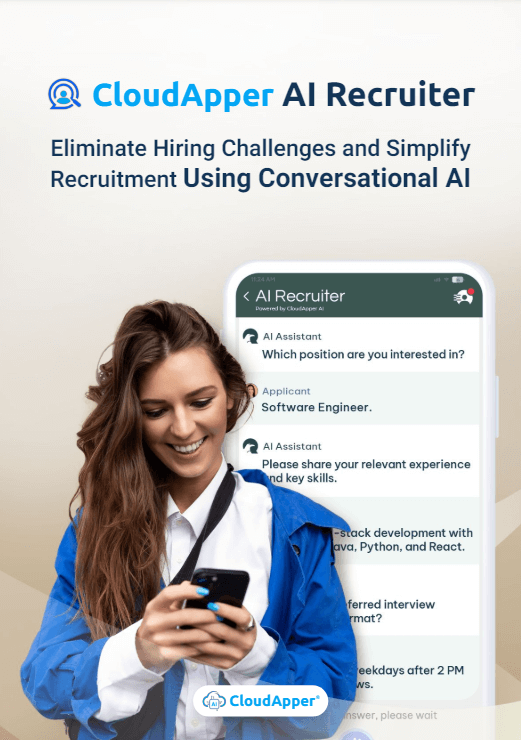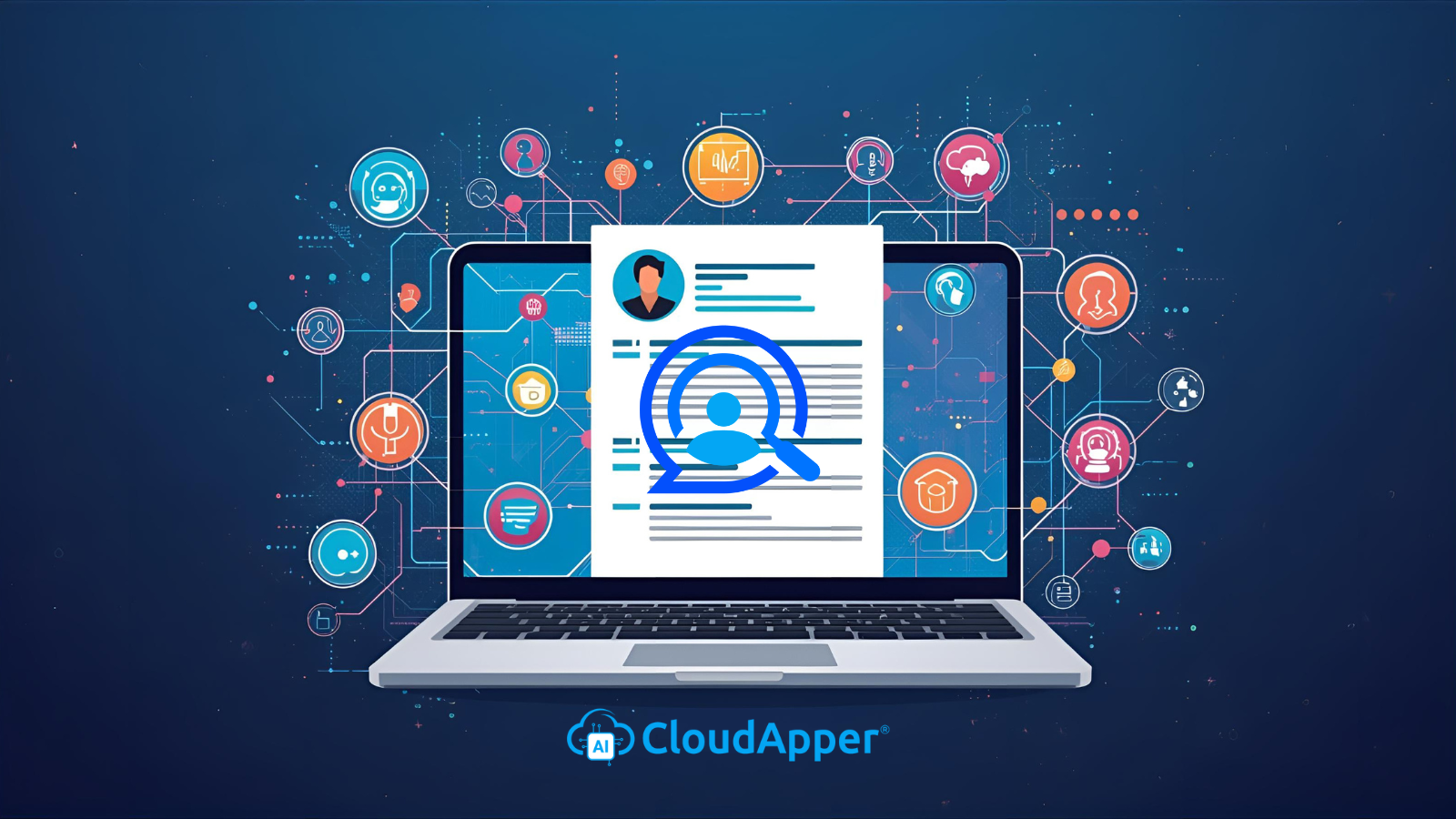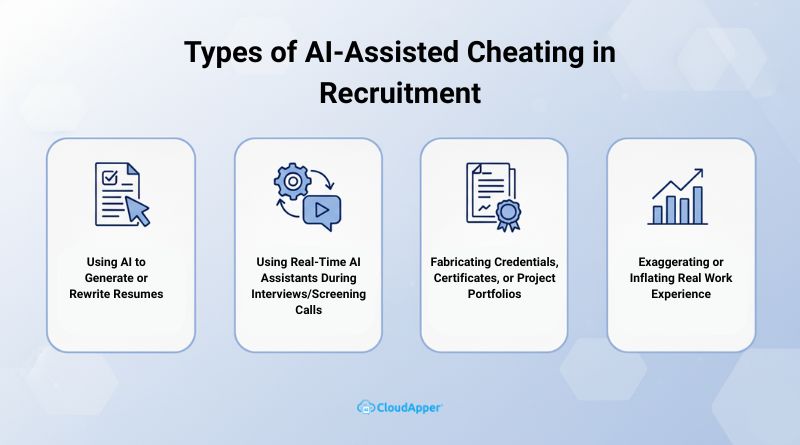AI-assisted cheating in recruitment is growing rapidly, making it harder to spot fake experience. This article breaks down the most common tactics candidates use and shows how CloudApper AI Recruiter verifies real skills through scenario-based screening.
TL;DR
- AI-assisted cheating in recruitment is rising fast, from resume rewrites to real-time AI interview assistance.
- Traditional ATS and phone screens can’t verify true experience; they only detect keywords.
- CloudApper AI Recruiter uses scenario-based pre-screening, video responses, and follow-up validation to verify real skills.
- Candidates using AI to cheat struggle when asked for real examples, decisions, or reasoning, which exposes fake experience quickly.
- Recruiters save hours by focusing on verified talent, reducing bad hires and wasted interviews.
Table of Contents
Last month, I talked to a hiring manager who was furious. She’d interviewed a software developer who sailed through the phone screening with perfect answers. But during the technical interview? He couldn’t explain basic concepts he’d supposedly mastered.

For more information on CloudApper AI Recruiter visit our page here.
Turns out, the candidate used AI to cheat during the screening call.
This isn’t a one-off story. AI-assisted cheating in recruitment has become widespread. I’ve worked with dozens of CloudApper customers dealing with the same problem. AI has made it incredibly easy for candidates to fake their way through pre-screening. And traditional resume scanning? It’s not catching any of it.
Here’s what’s actually happening out there, and more importantly, how you can spot it easily with CloudApper AI Recruiter.
The 4 Common Types of AI-Assisted Cheating Recruiters Miss
1. The AI Resume Rewriter
This is one of the most common types of AI-assisted cheating in recruitment. You know that junior marketing coordinator who suddenly has a resume talking about “spearheading integrated campaigns” and “optimizing conversion funnels”? Yeah, that’s a classic case of AI resume fraud.
Candidates are taking their basic job duties and running them through AI. What comes out looks impressive. Every bullet point has a metric. Every responsibility sounds strategic. The formatting is perfect.
One CloudApper customer showed me two versions of the same candidate’s resume. The LinkedIn profile said “helped with social media posts.” The resume they submitted? “Architected multi-channel social media strategy resulting in 150% engagement growth.”
Same person. Same job. Very different story.
The real problem? These AI-enhanced resumes pass your ATS filters perfectly. They have all the right keywords. The structure is flawless. But there’s no substance behind the polish.
Red flags to watch for:
- Every single bullet point follows the exact same format
- Accomplishments that seem too big for the role level
- Language that’s way too formal for someone with 2 years of experience
- Vague context around who they worked with or what tools they actually used
Here’s what I tell recruiters: if a resume reads like a textbook, it probably was written by something that learned from textbooks.
QUICK CHECK: How to Check if a CV is AI-Generated
CloudApper AI Recruiter automatically screens resumes and then asks real-life scenario-based questions tailored to the specific skills mentioned in the candidate’s CV. Based on how candidates respond to these scenarios, the AI Recruiter either moves forward with promising candidates or politely rejects those who can’t prove their claims. No more manually checking every resume for red flags.
Why this works: Anyone can have AI write an impressive resume, but they can’t fake answers to specific scenario questions about skills they don’t actually have. The AI Recruiter verifies every claim automatically and helps you catch AI-written resumes.
2. The AI-Powered Real-Time Assistant
Let’s say you’re on a video call with a candidate. You ask a technical question. They pause for exactly 8 seconds. Then deliver a perfectly structured, textbook-perfect answer.
Every. Single. Time.
They’ve got ChatGPT or Claude open on another screen. You ask, they type or let AI listen to the question, AI answers, and they read it back to you.
I worked with a tech recruiter who got suspicious when a junior developer was giving answers that sounded like documentation. Word for word. She started asking follow-up questions that needed immediate responses. “Why did you choose that approach over this one?” The candidate fumbled every time.
The tells:
- Consistent delays before answering (they’re waiting for AI to respond)
- Answers sound rehearsed or overly formal
- Can describe what to do but not why they’d do it that way
- Struggles with spontaneous follow-ups
Real experience comes with opinions, preferences, and the ability to improvise. AI-generated answers don’t.
QUICK CHECK: How to Tell if a Candidate is Using AI During Interviews
The smart approach: CloudApper AI Recruiter asks candidates to submit video-recorded answers to pre-screening questions. After analyzing the submitted videos, the AI Recruiter asks follow-up questions based on real-life hypothetical scenarios to detect whether the candidate is using live AI interview assistants or not.
Why this works: AI can generate generic answers, but it can’t make up actual experiences. When candidates have to respond to unexpected scenario-based follow-ups on video, their authentic knowledge (or lack of it) becomes obvious. No proxy can help. No real-time AI assistance works. Just the candidate and their real experience.
3. The Credential Fabricator
Fake certificates. Made-up bootcamp completions. Project portfolios that never existed.
AI makes it easy to create legitimate-looking credentials. Generate a certificate design. Fill in the details. Boom. You’re now a “certified” whatever.
But here’s where they trip up: They can’t talk about the actual learning. Ask them about a specific module from that certification or a challenge from that portfolio project. If it’s fake, they’ll give you surface-level answers with no depth.
A CloudApper customer once interviewed a candidate with an impressive portfolio. Ten complex projects. All completed in four months. When asked about debugging one of them, the candidate couldn’t explain a single technical decision.
Those projects? AI-generated descriptions of things that never got built.
Red flags:
- Portfolio projects with no GitHub links or live demos
- Can’t explain why they made specific technical choices
- Timeline doesn’t add up (too many complex projects in too little time)
- Generic answers about “challenges faced”
4. The Experience Synthesizer
This is the sneakiest one.
The candidate actually worked at the company they listed. The job title is real. But the responsibilities? Completely fabricated with AI’s help.
They were a “Marketing Coordinator” but the resume says they “led brand strategy for Fortune 500 clients.” They were on the team, sure. But leading? No.
The verification is hard because the basics check out. Call the company? Yes, they worked there. Check the dates? They match. But the scope of what they actually did? Totally inflated.
What to look for:
- Responsibilities that don’t match typical duties for that title
- Claimed authority that seems too high (budget decisions, team leadership, strategic direction)
- Can’t name specific people they worked with in detail
- Vague when asked about approval processes or decision-making hierarchy
When you dig into the details with scenario questions, the story falls apart. They can’t tell you who approved their “strategy.” They don’t remember the budget they supposedly managed. The specifics aren’t there.
You don’t need more interviews — you need proof of real experience.
Why Traditional Pre-Screening Misses All This
Your keyword scanning looks for terms on a resume. It doesn’t verify truth.
Your ATS filters check if “project management” appears three times. It doesn’t check if the person actually managed projects.
Generic phone screens with the same five questions? Candidates have AI-generated answers ready for all of them.
This is why we built CloudApper AI Recruiter differently. We don’t just scan for keywords. We ask scenario-based questions that force candidates to prove their claims with real, specific examples and prevent AI-assisted cheating in recruitment right from the roots.
Because here’s the thing: AI can write a resume. It can generate interview answers. But it can’t fabricate authentic personal experiences.
When you ask, “Tell me about a time you had to convince a stakeholder to change direction,” AI can give a generic story. But when you follow up with “What was the stakeholder’s specific objection and how did you address it?”… that’s where fake experience breaks down.
How to Implement CloudApper AI Recruiter to AI-Assisted Cheating in Recruitment
Look, I get it. Reading about AI cheating is one thing. Actually stopping it is another.
The good news? Getting CloudAapper AI Recruiter up and running is straightforward. No complicated setup. No technical headaches. Here’s how it works:
Step 1: Talk to Our Solution Experts
First, you’ll have a conversation with our team about what you’re actually dealing with. What roles are you hiring for? What specific challenges are you facing? Are candidates failing at the technical round? Are you spending too much time on unqualified applicants?
Step 2: We Build Your Custom Solution
Based on that conversation, our solution experts build your AI Recruiter. This includes setting up the scenario-based questions tailored to your specific roles and the skills you’re looking for..
Step 3: Test Run for Quality Assurance
Before you start using it with real candidates, we run tests. We check for bugs. We make sure the scenario questions make sense. We verify that the AI is evaluating responses correctly.
Step 4: Start Hiring Smarter
Once everything checks out, you’re ready to go. Your recruiters can start using the AI Recruiter for actual hiring campaigns. Candidates submit their resumes, answer scenario-based questions on video, and the AI handles the verification automatically.
The Bottom Line
AI-assisted cheating isn’t going away. It’s getting easier and more sophisticated. But candidates can’t fake real experience when you know what questions to ask. One bad hire costs you three times their salary. Plus, the time wasted on interviews. Plus, the impact on your team. It’s worth taking the extra few minutes to verify that what you’re seeing is real.
Let CloudApper AI Recruiter verify every claim before you waste another interview slot.

Reduce Time-to-Hire by 97% with AI for Talent Acquisition
Recruit skilled, culturally fit, and diverse candidates with CloudApper’s state-of-the-art AI resume screening, automated interview scheduling, and offer letter generation.
Learn more | Download BrochureFrequently Asked Questions
-
What is AI-assisted cheating in recruitment?
AI-assisted cheating in recruitment happens when candidates use tools like ChatGPT or other AI systems to create inflated resumes, fake portfolios, or real-time interview answers that do not reflect their true skills or experience.
-
How can recruiters detect AI-generated resumes?
Recruiters can detect AI-generated resumes by looking for repetitive phrasing, overly formal language for junior roles, accomplishments that seem unrealistic, and vague context around tools, teams, or outcomes. Scenario-based questions tied to resume claims help expose AI-written content.
-
What are common signs that candidates are using AI during interviews?
Common signs include consistent pauses before answering, textbook-perfect responses with little personal detail, difficulty handling spontaneous follow-ups, and an ability to describe what to do but not why they would choose a specific approach in real situations.
-
How does CloudApper AI Recruiter help stop AI-assisted cheating in recruitment?
CloudApper AI Recruiter uses scenario-based pre-screening and video responses to verify real experience. It asks tailored, real-life questions based on resume claims and follow-up questions that expose fake experience, resume inflation, and candidates relying on AI instead of genuine knowledge.
-
Does CloudApper AI Recruiter replace human recruiters?
No. CloudApper AI Recruiter supports human recruiters by automating screening, verification, and red-flag detection. It filters out unqualified or deceptive candidates early so recruiters can focus their time on interviewing and hiring applicants who demonstrate real skills and experience.
What is CloudApper AI Platform?
CloudApper AI is an advanced platform that enables organizations to integrate AI into their existing enterprise systems effortlessly, without the need for technical expertise, costly development, or upgrading the underlying infrastructure. By transforming legacy systems into AI-capable solutions, CloudApper allows companies to harness the power of Generative AI quickly and efficiently. This approach has been successfully implemented with leading systems like UKG, Workday, Oracle, Paradox, Amazon AWS Bedrock and can be applied across various industries, helping businesses enhance productivity, automate processes, and gain deeper insights without the usual complexities. With CloudApper AI, you can start experiencing the transformative benefits of AI today. Learn More

CloudApper AI Solutions for HR



- Works with
- and more.
Similar Posts

How AI Answers Candidate Questions Instantly — Even When Your…

Contextual Resume Analysis to Identify Real Job Skills

















